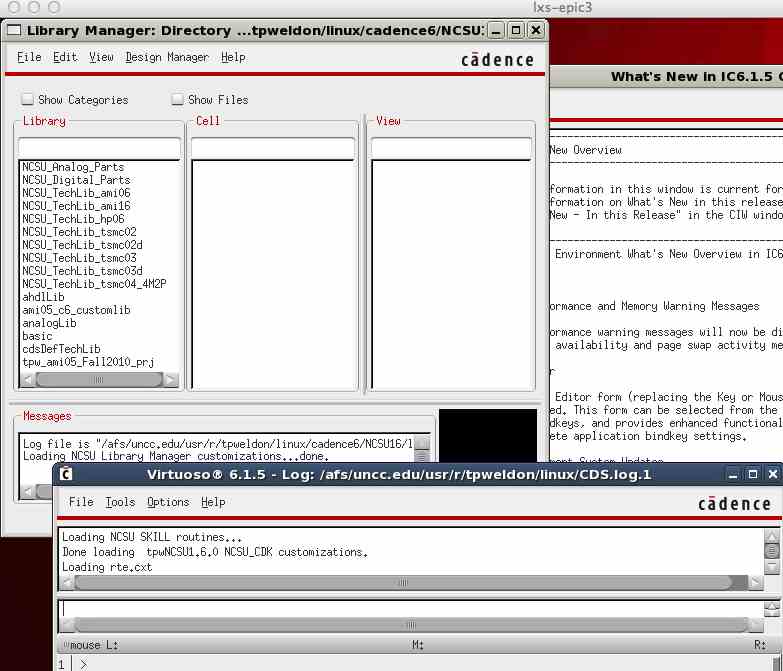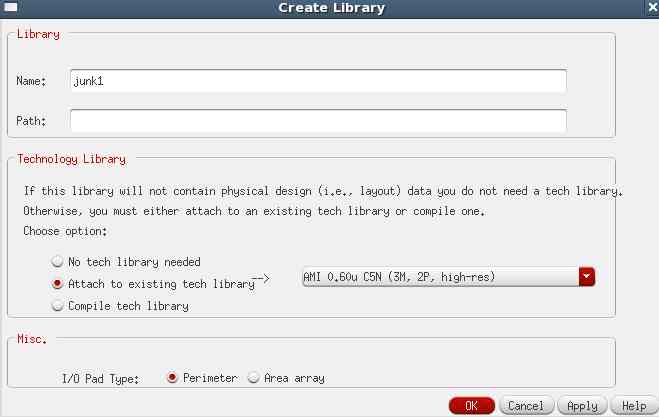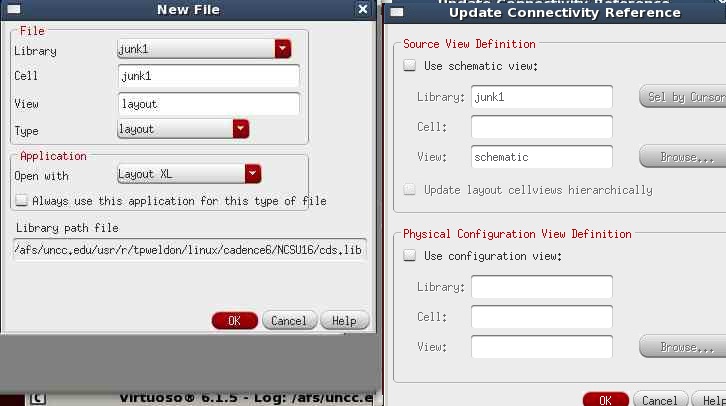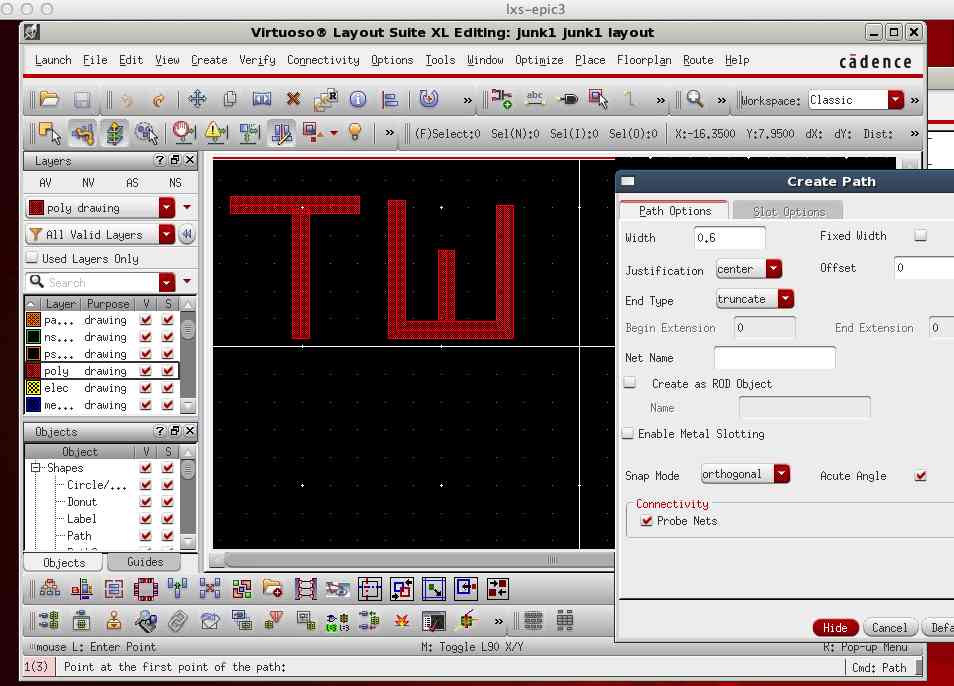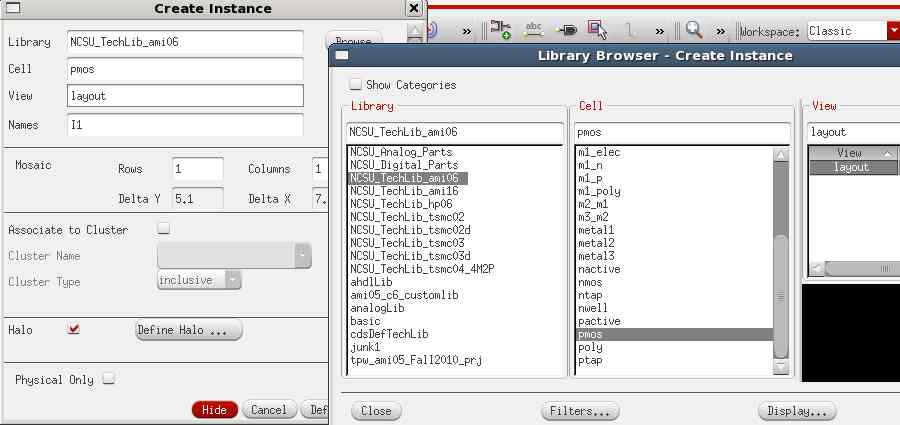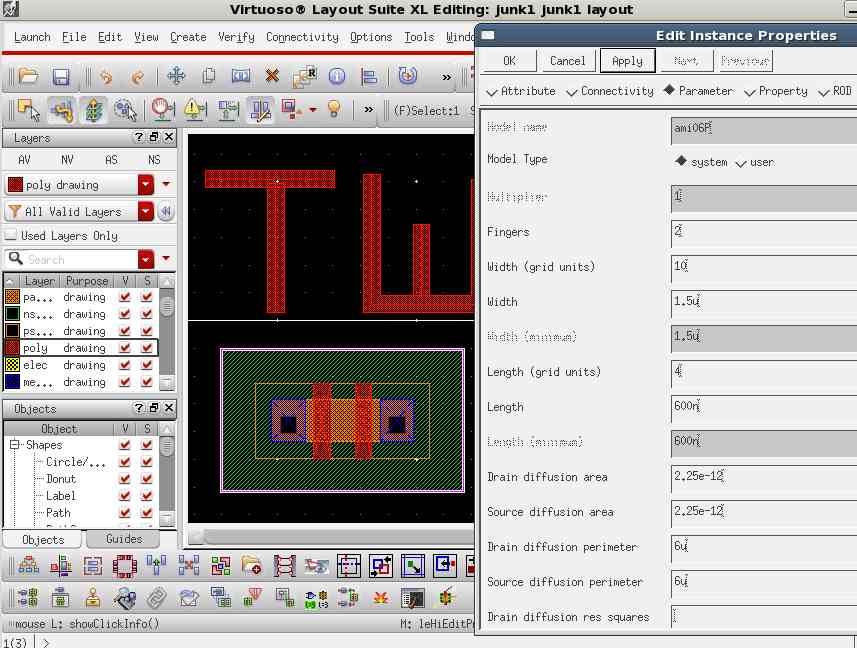UNC Charlotte Agilent ADS and Cadence Software Tutorial
(Project 1)
Overview
First, form project groups for the
semester.
The objective of the tutorial is to become familiar with the basics
of Agilent ADS software and Cadence software.
NOTE: Use the Project
Report Template and keep answers
to questions on consecutive sheets of paper with all plots at
the end.
IN NO CASE may code or files be exchanged between students, and
each student must answer the questions themselves and do their own
plots, NO COPYING of any sort! Nevertheless, students are
encouraged to collaborate in the lab session.
Only turn in requested plots (Pxx )
and requested answers to questions (Qxx ).
Part 1
Part 2
Start the software:
Download the following zip-file (you may need to hold down
the shift key while you click on the link):
aatpwx1_wrk.zip
When ADS first runs, you should have a new directory
apps/ads created in your home directory.
Move the zip-file into the app/ads directory and
extract the archive
You should find a new directory aatpwx1_wrk created in
apps/ads or whatever your default ADS startup directory is.
Run ADS
Go down through the directory tree to ads/aatpwx1_wrk, and
double click that design file.
If you also single click the folders in the FileView
(FileView tab), you should see the directory structure:
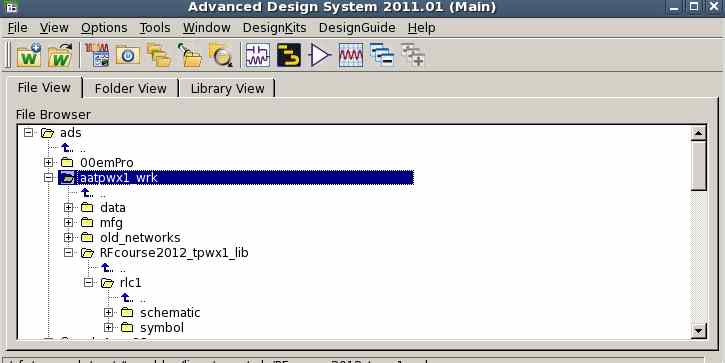
Select the FolderView tab as below, and double-click the
schematic in the folder view:

And the following schematic should appear.
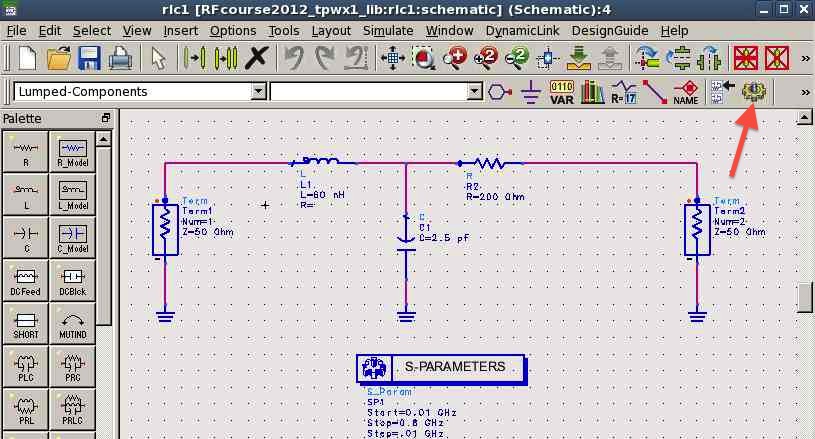
Save a snapshot of the schematic and turn it in. (P2 )
Double-click the "gear" icon (shown at the red arrow above)
in the upper right of the window to simulate.
The data plotting window shown below should appear.
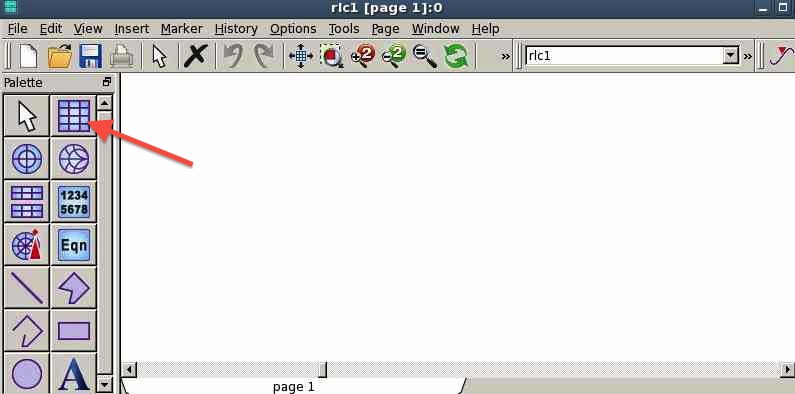
To plot the simulation results, click the "rectangular plot"
icon indicated by the red arrow above in the left of the
window .
Drop the plotting box in the visible area, and in the pop-up
window:
Select DataSet -> S(1,1) -> Add -> dB
Select DataSet -> S(2,1) -> Add -> dB
The screen should appear as:
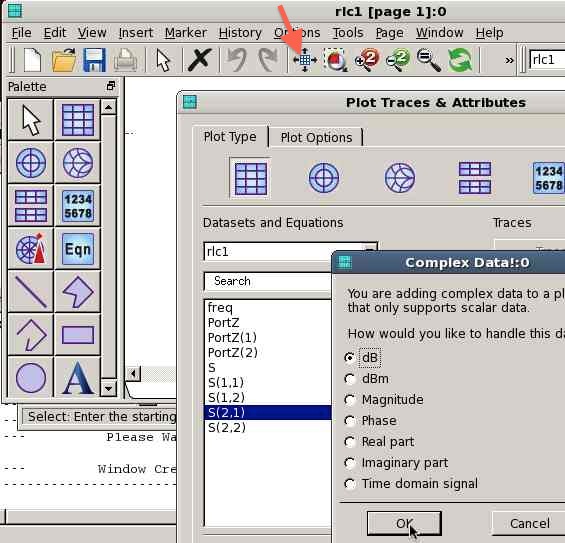
Click OK, and the following S-parameter plot should
appear. Click on the "ViewAll" widget indicated by the
red arrow in the figure above,
and yu should see a plot as below.
S11 is a measure of the reflected wave as a function of
frequency.
S21 is a measure of gain.
S-parameters will be investigated in greater depth in the
next project.
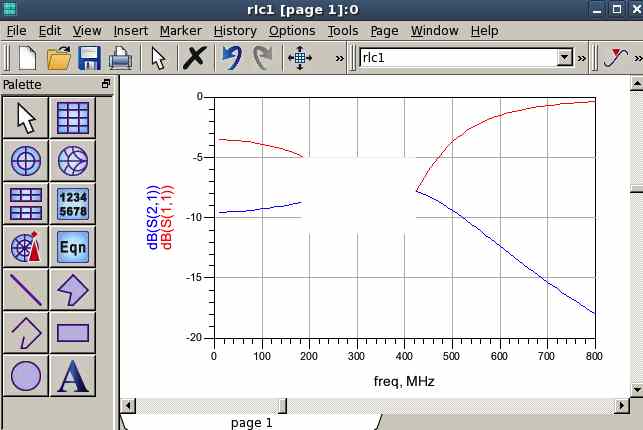
Save a snapshot of your plot, as above, and turn it in. (P3 )
Part 3
Install Cadence software
Note for previous users
of Cadence:
DO NOT RUN ANY CADENCE SOFTWARE UNTIL YOU SAVE ALL OLD FILES
Please note that any old files may be overwritten by the new
installation in Aug 15 2012.
If you were a previous user of Cadence software, you are
strongly urged to first move your cadence directory to
something such as "cadence_old" and move your cadence6
directory to something such as "cadence6_old" to prevent any
destruction of old data
Saving to an external usb drive is probably also a good idea
From a Linux terminal, Cadence6/Virtuoso should be available
in the menu
(Mosaic->Engineering->Electrical->Cdence->Cadence6)
From a PC terminal, you must first open a remote Linux
session,
(Start->AllPrograms->Mosaic->LinuxConnect->ToAnyServer),
then proceed as for a Linux terminal
As soon as you run Cadence software for the first time, it
will automatically install all NCSU ami06 libraries in your
cadence6 director. The ami06 libraries will be used to
fabricate in the ON Semiconductor 0.5 micron process through MOSIS.com
Note: installation may take a few
minutes after you accept the pop-up prompt to have
this installed... so wait until the following windows appear
on your screen.

If all goes well, you should see something like:
Save a snapshot of your Library manager window as above ( P4 )
Create a new library using MenuBar::File::New::Library
from library manager menu bar and use the input parameters as
shown below to create a 0.5 micron design:
Next create a new cell in cadence using the
MenuBar::File::New::CellView from library manager menu bar and
use the input parameters as shown below to create a 0.5 micron
design.
NOTE: a common bug in Cadence is that
the new popup window is hidden behind your other windows
Set all layers to be
visible using MenuBar::Options::Display and set display
levels to Start=0 Stop=32 in the display options
pop-up menu,
and also click the PinNames and Instance options as below.
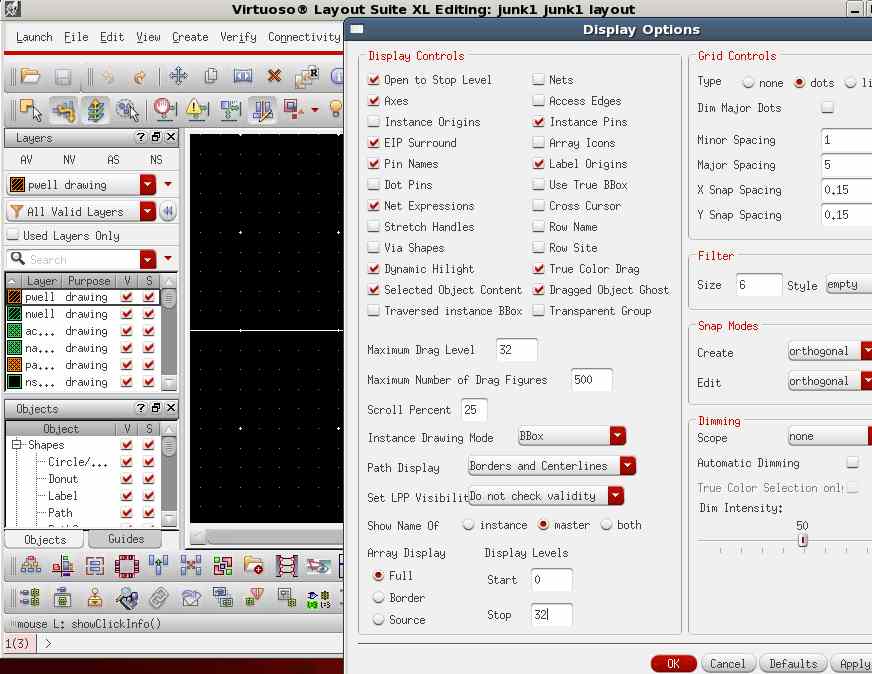
Select the poly material in the left side of the screen (see
below) and use the MenuBar::Create::Shape::Path command to
draw your initials in poly.
Next create a PMOS transistor with the command
MenuBar::Create::Instance and select the following parameters
- Place the transistor near your initials as in the following
figure
- Using MenuBar::Edit::Basic::Properties select the transistor
and edit the transistor property (2-finger gate) as follows:
Select the transistor and edit the transistor property for a
1-finger gate and with multiplier=4 to observe a transistor
with multiple source/drain contacts appropriate for an
intergdigitated device layout equivalent to 4 devices in
parallel
Save a snapshot of your first RFIC Chip Layout with your
initials and a multiplier=4 PMOS transistor ( P5 )
Finally, run a DRC (Design Rules Check) using
MenuBar::Verify::DRC as below:
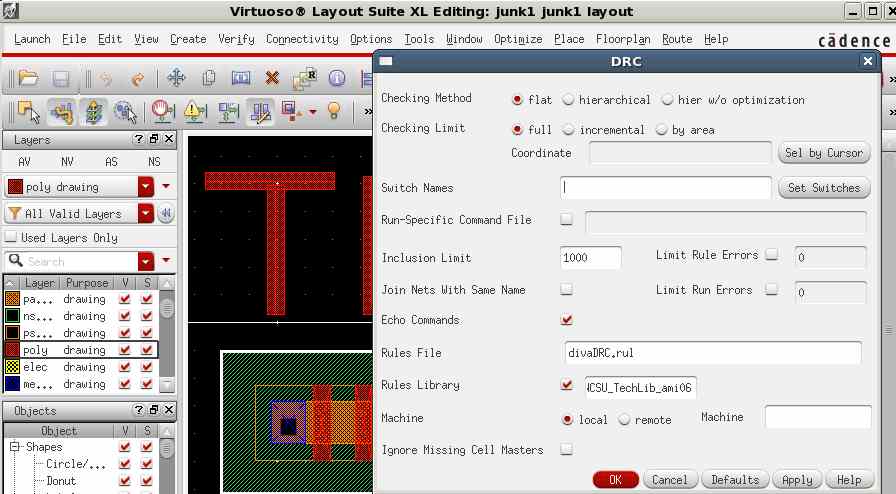
Observe the error summary that appears in the ICFB text
window area that opened when you first started Cadence:
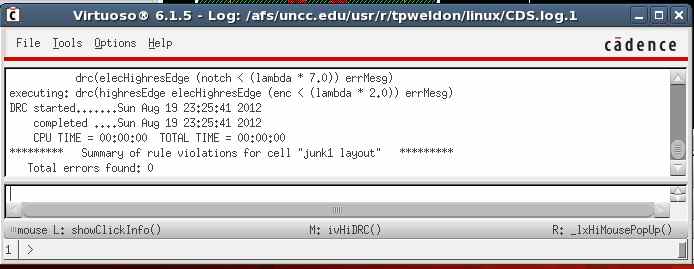
Dont worry about any errors, just print whatever errors you
have as shown above ( P6 )
More tutorials are at a variety of other websites.see also
http://www.eda.ncsu.edu/wiki/NCSU_EDA_Wiki
http://www.seas.upenn.edu/%7Eeecad/cadence/cadence.html
http://www.cadence.com/support/university/Pages/default.aspx
http://www.cs.utah.edu/cadence/
http://www.cadence.com/support/university/ww_usp.aspx
http://www.ece.umd.edu/~dilli/research/layout/cadencetutorial/cadencedemo9.html
http://coefs.uncc.edu/tpweldon/cadenceproductsatunccharlotte/
Part 4
Look at the on-line manuals (see the help tab in ADS), then
answer the following questions and turn them in. It is usually
best to use help index accessible from an ADS window to search
the manuals.
In what year did Heinrich Hertz demonstrate radio wave
propagation? (Q1 )
In what year did Marconi make the first transatlantic
transmission from Glace Bay Nova Scotia? (Q2 )
In 1971, what did Federico Faggin design for Intel? (Q3 )
Most microwave oven operate at a frequency of 2.45
GHz. What is the maximum clock frequency of an Intel
I7 Ivy Bridge 22nm CPU? (Q4
)
Report
NOTE: Use
the Project Report Template
and keep answers to questions on
consecutive sheets of paper with all plots at the end.
Do not add extraneous pages or put explanations on separate
pages unless specifically directed to do so. The instructor will
not read extraneous pages!
Only turn in requested plots (Pxx )
and requested answers to questions (Qxx ).
All plots must be labeled P1, P2, etc. and all questions must be
numbered Q1, Q2, etc. YOU MUST ADD CAPTIONS AND FIGURE
NUMBERS TO ALL FIGURES!!
Copyright © 2010-2012 T. Weldon
Cadence, Spectre and Virtuoso are registered trademarks of
Cadence Design Systems, Inc., 2655 Seely Avenue, San Jose, CA
95134. Agilent and ADS are registered trademarks of Agilent
Technologies, Inc.













